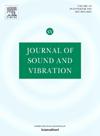Vibrations of gyroscopic continua: Rotating structures and axially moving structures
IF 4.9
2区 工程技术
Q1 ACOUSTICS
引用次数: 0
Abstract
Gyroscopes, rotors, blades, axially moving structures, and pipes conveying fluid, have been widely applied in engineering fields such as aviation, aerospace, and other industries. These structures and devices belong to the class of gyroscopic continua. Gyroscopic continua, subjected to gyroscopic effects, exhibit significant non-self-adjoint properties, which complicate the analysis of the natural properties of the system. In this review, the vibration investigations of gyroscopic continua, both rotating structures and axially moving structures, are surveyed and discussed. Through kinetic energy analysis, the different genesis of gyroscopic terms in both axially moving and rotating structures have been compared. Gyroscopic continua are categorized into two types in this paper: rotating continua, axially moving continua. Representative governing equations for various types of continua are reviewed. All the mode analysis of gyroscopic continua yields complex modal solutions. The paper focuses on analyzing the impact of centrifugal effects, gyroscopic coupling, and nonlinear effects on the governing equations and modal parameters, where frequency bifurcation and traveling wave modes are classical characteristics of gyroscopic systems. In addition, the stability and practical engineering applications of gyroscopic continua are reviewed in terms of axially moving continua and continua with distributed gyros, respectively. Lastly, the paper offers some suggestions for future research directions in this field.
陀螺连续体的振动:旋转结构和轴向运动结构
陀螺仪、旋翼、叶片、轴向移动结构、输送流体的管道等已广泛应用于航空、航天等工程领域。这些结构和装置属于陀螺连续体类。陀螺连续体受陀螺效应的影响,表现出明显的非自伴随性质,使系统自然性质的分析复杂化。本文综述和讨论了陀螺连续体的振动研究,包括旋转结构和轴向运动结构。通过动能分析,比较了轴向运动和旋转结构中陀螺项的不同成因。本文将陀螺连续体分为两类:旋转连续体和轴向运动连续体。回顾了各种类型连续体的代表性控制方程。所有的陀螺连续模态分析都得到复模态解。本文重点分析了离心效应、陀螺耦合和非线性效应对控制方程和模态参数的影响,其中频率分岔和行波模态是陀螺系统的经典特征。此外,还分别从轴向运动连续体和分布陀螺连续体两方面综述了陀螺连续体的稳定性和实际工程应用。最后,对该领域未来的研究方向提出了建议。
本文章由计算机程序翻译,如有差异,请以英文原文为准。
求助全文
约1分钟内获得全文
求助全文
来源期刊

Journal of Sound and Vibration
工程技术-工程:机械
CiteScore
9.10
自引率
10.60%
发文量
551
审稿时长
69 days
期刊介绍:
The Journal of Sound and Vibration (JSV) is an independent journal devoted to the prompt publication of original papers, both theoretical and experimental, that provide new information on any aspect of sound or vibration. There is an emphasis on fundamental work that has potential for practical application.
JSV was founded and operates on the premise that the subject of sound and vibration requires a journal that publishes papers of a high technical standard across the various subdisciplines, thus facilitating awareness of techniques and discoveries in one area that may be applicable in others.
 求助内容:
求助内容: 应助结果提醒方式:
应助结果提醒方式:


